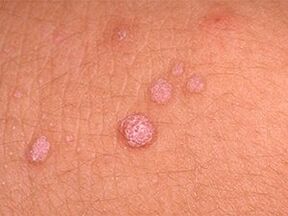Papillomas on the body are a common situation in dermatological practice.The main places are armpits, neck, groin and genitals and face.Most neoplasms have a benign course, but the risk of transformation into skin cancer or oncology at any other localization increases under the influence of many negative factors.
Why are papillomas dangerous to the human body?

Viral tumors on the body are usually caused by strains with rather low oncogenic danger and a minimal risk of cell degeneration.Cellular atypia experiences rapid growth and changes in the structural characteristics of papillary lesions.
Today, especially dangerous strains include HPV types 15, 16, 18, 35, 51-59, 66-68.Interestingly, the location of a cancer tumor during the human papillomavirus infection can be absolutely any.
Papillomas on the body appear in the form of wart neoplasms, calves, flat or genital warts.The dangers and complications caused by HPV usually differ between men and women.
Papillomavirus complications in men
Often, it is the man who becomes infectious strains and transmits them to women through unprotected sexual contact.The main localization of papillomas on the body in men are genitals, genitals, frenulum and foreskin;Papillomas are often formed in the anus in men.Sometimes there are growths in the armpits and neck.
Symptoms depend directly on location.Clinical manifestations are more characteristic of the location of papillomas in the genitals.Usually neoplasms are not accompanied by obvious symptoms.
Men's main complications are:
- Prostate cancer;
- Throat and larynx cancer;
- sexual impotence;
- infertility;
- erectile dysfunction;
- development of adenocarcinoma;
- Malignant intestinal tumors.
The transformation of healthy cells into cancer cells is facilitated by:
- Bad habits,
- difficult working conditions,
- Frequent stress,
- constant injury to papillary lesions;
- Insufficient hygiene.
Women's Dangers Characteristics
In the absence of adequate treatment, HPV in women threatens even more complications due to the peculiarities of the anatomical structure of the genital organs and hormonal levels.
The main complications are:
- Cervical cancer and appendages;
- vulva dysplasia, vaginal vault, cervical canal;
- uterine structure cancer;
- Large genital warts if the papilloma is diagnosed in the groin in women;
- Malignant change in the mucous membranes of the pharynx, genital organs;
- Genodermatous warts according to the type of pathology of Lewandowski-Lutz;
- Esophageal and larynx cancer;
- Plant cancer.
The location of warts and warts in the lumen of the urethral canal leads to a disruption of the leakage of the urine.When localized in the larynx - hoarseness and impaired respiratory function.
Unfortunately, many women perceive any new skin growths only in terms of cosmetic problems.By removing papillomas, they hope that they have completely solved the HPV problem.When a viral infection is active, the eliminated tumors reappear and with a greater intensity.
It is important to recognize the signs of malignancy in time in time:
- Changes in the shape, size and structure of growth;
- Instruability of the shadow of the papillary lesion:
- Painful growth sensations;
- Continuous trauma, bleeding, infection.
Regular exposure to negative factors contributes to the instability of growth and stimulates changes in cells in cancer.
If papillomas occur, it is recommended that you consult a dermatologist to clarify the nature of the pathological rash.
Are papillomas contagious on the body?

Papillomas on the body transmitted from person to person?Given the high infection of human papillomavirus infection, patients are wondering about the possibility of contraction of the virus by contact with foci of viral tumors on the skin.The answer is clear - it is almost impossible to "capture" the virus when touching papillomas.
However, if the skin of the carrier and a healthy person in the contact area is damaged, the risk of infection increases.
There are other ways to transmit infection:
- sexual contact;
- work activity;
- Contact route (during a long stay with a virus carrier).
You can also get infected in public places, especially in baths, saunas, changing rooms and pools.
There is a concept of self -infection when an early papilloma causes many others on the entire surface of the body.
The penetration of the virus into the human body does not mean that skin rashes will certainly appear after a while.With a high immune response to the human body, the volume of antibodies is sufficient to suppress the viral activity of all strains and against the background of good health the virus does not appear at all for the rest of life.
Of course, even if a person has no symptoms, he remains a carrier of a viral infection.
Many papillomas have appeared on the body, what does this mean?
The appearance of papillomas on the body in different places characterizes the activation of viral strains.Multiple papillomatous outbreaks signal an increased risk of malignancy.Increasing the pathogenic activity of viral strains is due to reduced immunity with a sustainable progressive course.
The following can cause a decrease in the body's immune response:
- colds;
- hypothermia;
- Stress factor;
- alcoholism and drug addiction;
- constant hormonal disorders;
- pregnancy, abortion;
- Chronic pathologies of the internal organs.
Viral activity can be triggered by the simple inability to observe the rules of personal hygiene.Somatic multiple papillomas explain the pathologies of the internal organs and systems.HPV is often combined with other viral diseases, such as herpes infection.
Papillomas have spread throughout the body - what should I do?

When multiple papillomas occur, it is important to undergo a differential diagnosis.The professional doctor usually immediately notes the nature of the rash and shows the possible cause of tumors.
The main methods of research are:
- Blood test for antibodies to viruses;
- Digen Test to identify the type of strain, viral structure and level of oncogenic danger;
- Polymerase chain reaction to detect viral DNA;
- Cytological examination of biological material from the cervical canal;
- Histological examination of samples by the female genital organs;
- Analysis of warts or warts.
A preliminary diagnosis is usually made during the first examination of the patient.Based on the results of the patient's studies and the patient's clinical history, a viral infection is diagnosed or excluded.It is important to separate HPV from dermatological diseases, cancer and herpes virus.
Fighting papillomas on the body
Today, there is no effective therapy for viral infection, but official medicine is able to create conditions for stable remission and prevent skin rashes.The infection itself is not dangerous, but the formation of papillomas increases the risk of cell disease and the onset of tumors.
Treatment
A promising direction is drug therapy:
- Immunomodulators based on interferons to stimulate the immune system;
- Antiviral agents;
- Vitamins to create strong immunity and restoration of the body;
- Local papillomas removal preparations.
In the case of secondary infection, bacterial therapy and antiseptic treatment are prescribed.
Non -steroidal anti -inflammatory drugs are suitable for relieving pain.
Removal
Tumor removal is possible with modern hardware techniques and cosmetic surgery.
There are several effective methods for cutting tumors:
- scalpel;
- laser;
- radio wave;
- Cross -depressing;
- chemical;
- electrocoagulation.
No surgery prevents the more and more pathological formation.Without adequate antiviral treatment, the removal of external signs only gives temporary results.
HPV is a common infection that can be shrunk through sexual contact as well as through a regular kiss.The main prevention is to vaccinate a child aged 12-14 years before the first sexual experience.It is important to monitor the hygiene of the skin and genitals.Unfortunately, even barrier contraception methods are not able to guarantee 100% protection against human papillomavirus infection.The timely response of rash patients is the key to safe and quick treatment, including the prevention of the risks of cancer tumors.























